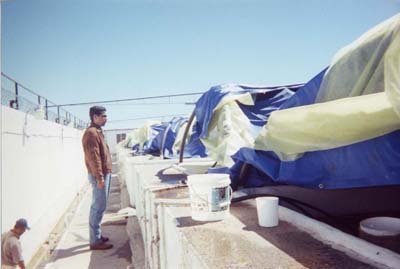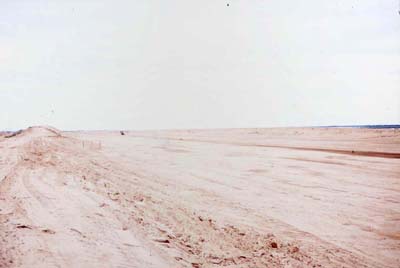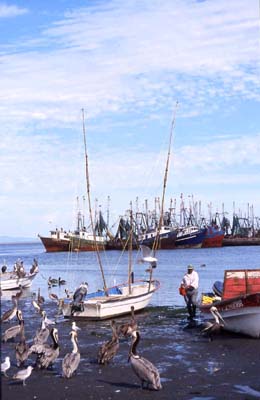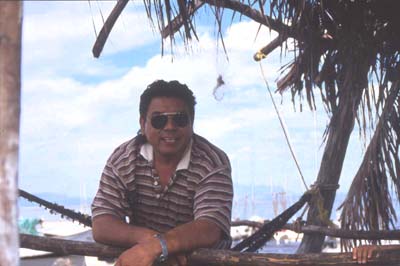A mass of gulls hung like kites in the clear air above a shrimp farm in Sonora, Mexico. The birds indicated a situation familiar in every country where shrimp are grown. “Birds are the first sign of disease,” said Jose Reyna, a technical consultant for Camaron Dorado, a shrimp hatchery in Santa Barbara, Sonora, on the Gulf of California.

From the gulls’ view, a grid work of earthen dykes bulldozed out of the alluvial plain, created a patchwork of shallow ponds ranging in size from four to ten hectares. Disease ridden shrimp languished near the surface of the water, and the gulls dove down to the feast while workers hurried to harvest the remaining shrimp and ship them to market. Similar scenes have been repeated on shrimp farms from India to Ecuador, Thailand to Texas. In Ecuador, the largest farmed shrimp producer in the western hemisphere, viral disease epizootics cut production by 58 percent in 1994. While the incidence of outbreaks has declined, losses from two major viruses, Taura and white spot, can still reach as high as 100 percent on affected farms, threatening not only the fastest growing seafood industry in the world, but wild shrimp stocks, and possibly human health as well.

“Disease is the biggest single impediment to aquaculture development,” according to Rohana Subasinghe, Senior Fisheries Research Officer for the United Nations’ Food and Agriculture Organization (FAO). Subasinghe acknowledges that exotic pathogens and environmental stress may also threaten wild stocks, but he stays focused on the health of farmed shrimp and the growth of the aquaculture industry.
Mexico’s shrimp farming boom came late compared to other countries; from 1992 to 2001 however, the industry’s output jumped from 8,325 metric tons to an estimated 25,000 metric tons, 90 percent of that production came from Sinaloa, and Sonora on the northwest coast. The only thing that has slowed development has been disease.
The pathogens plaguing aquaculture are often exotic viruses, suspected to have spread through a variety of pathways including international trade in aquaculture products. Taura virus for instance, emerged in Ecuador in 1992, spread through many Mexican shrimp farms, and later appeared in Asia after farms there were stocked with Ecuadorian shrimp.
In 1995, the continuing emergence of new viruses elsewhere in the world led Mexico to establish a program to certify imported shrimp and other crustaceans as disease free. Nonetheless, white spot syndrome virus (WSSV), first identified in Taiwan in 1992, broke out in Mexico in 1999.
The infection of wild shrimp raises concerns, but most scientists, managers, and producers, have devoted their resources to controlling disease within shrimp farms. “The problem is not the wild stocks, it’s the farm,” says Dr. Martha Zarain, of the Centro de Ciencias de Sinaloa, in Culiacan, Sinaloa. Zarain, who was the first to isolate the Taura virus in Mexico, suspects that waste from infected aquaculture shrimp, imported and processed near the coast, may have contaminated wild shrimp which then spread the virus to Mexico’s shrimp farms.
Early efforts to avoid disease relied on abandoning contaminated farms and expanding into clean waters. The white spot virus wiped out many shrimp farms in northern and central Sonora. “They’re still struggling with disease there,” says Reyna.
Consequently, shrimp farmers moved into the disease free waters of southern Sonora. Having reached the limits of that strategy however, growers have begun using disease resistant shrimp, and better management practices, such as lower density stocking. In addition Mexican law now requires that all farms be stocked with specific pathogen free (SPF) post larvae like those grown at Camaron Dorado.
Reyna believes these changes will put the world’s shrimp farms on the road to sustainable growth. “In twenty years it will be all aquaculture shrimp,” says Reyna. “There will be no need for a commercial fishery.”

The FAO’s Subasinghe has dedicated his life’s work to sustainable development. He points out that wild catch fisheries have flatlined and although they may increase slightly, due to better management, aquaculture will have to make up the growing deficit in per capita seafood production. “Right now aquaculture accounts for 30 percent of the world’s fisheries production,” he says. “In the next twenty years that will have to double.”
Subasinghe adheres to the economic theory that countries like Mexico should maximize exports of commodities such as shrimp, at the expense of production for local markets, and import basic foods if necessary. But he unlike Reyna, he predicts that wild capture fisheries will still be important. “Aquaculture will not bridge the food deficit, fisheries will also need to increase,” he says.
Sonora’s Agiabampo estuary system, which straddles the Sonora and Sinaloa border, was once recommended for protection as a national park. The area’s commercial fishermen steer their battered skiffs into Estero Bamocha, a 2,000 hectare estuary bounded by a mangrove covered peninsula and the cactus studded mainland of the desert coast. The thick fog that often blankets the region in the morning has started to thin. On the mainland, a dyke of raw red earth has been bulldozed into the water, breaking the continuity of the shoreline. The smell of an aquarium hangs in the air.

“Esta Camaronera [That is the shrimp farm],” say the fishermen. As they go about their business: hauling crab traps, netting shrimp and mullet, most express ambivalence toward more than 250 hectares of shrimp farms surrounding the estuary. Their neighbors who work the farms are at least not competing for the dwindling catches of wild shrimp.
Only Lalo Mendivil voices concern. A fisherman since he could walk, 32 year old Mendivil sees more than his own demise in shrimp aquaculture’s future. “When the damage that aquaculture does is finally acknowledged it will be too late,” he says. “Maybe if they wait long enough people will start to get sick.”
The threats of shrimp pathogens to human health are being investigated. A group of scientists in Los Mochis, Sinaloa, claims to have infected human cells with the polio like Taura virus, but as yet their results have not been conclusive. Dr. Zarain, points out that certain bacteria and antibiotic residues found in cultured shrimp can cause human health problems. “But the shrimp viruses are very host specific,” she says. Zarain maintains that shrimp viruses “pose no threat to humans,” noting that it is legal to harvest and sell shrimp that carry viruses.
Most scientists believe the viral pathogens cannot be eradicated, but extensive efforts have been launched worldwide to control disease in aquaculture. “It’s the same as the plagues we had with chicken and hogs,” says Dr. Christina Chavez, of the Centro de Investigacion en Alimentacion y Desarollo (CIAD), Mexico’s quasi-governmental research institute for sustainable development. “It’s just a matter of time until we get control of disease.”
Mexico and other shrimp producing countries, the United Nations Food and Agriculture Organization (FAO), and the World Trade Organization (WTO), rely on two approaches for disease management: avoiding the movement of shrimp without control, and avoiding the entrance of pathogens. The strategy also depends on the efforts of people like Jose Reyna, who hope to breed disease resistance into farmed shrimp.
One controversial solution, outlined in “The Bangkok Declaration for Aquaculture Development Beyond 2000,” calls for genetic engineering in farmed shrimp. The declaration, drafted at a conference organized by the FAO and endorsed by participants from 66 countries including the U.S. and Mexico, recommends, “developing and applying biotechnological innovations for advances in nutrition, genetics, health…”
Investors such as Sygen International, a UK based corporation and world leader in genetic engineering, have already moved in that direction. In October 2002, Sygen, which shared in an 8.2 million dollar research grant from the U.S., paid $.5 million cash for Super Shrimp, Mexico’s largest shrimp breeding stock business.
Subasinghe avoids the genetics issue; preferring to promote a global certification program for the safe movement of aquaculture products, including broodstock and post larvae used to stock the farms. The FAO plan calls for best management practices on farms, and pathogen free certification for all exported shrimp. “This is my mission,” says Subasinghe, “To create an industry that uses totally pathogen free post larvae, and grows them in a pathogen free environment.”
Jason Clay, of the World Wildlife Fund, shares Subasinghe’s vision of a pathogen free shrimp aquaculture industry. Clay, who helped draft the Bangkok Declaration, believes that small, highly intensive systems being developed in Peru and Belize offer the best chance of achieving that end. Although stocking densities would be as high as 140 shrimp per square meter, 10 times the industry norm, the small, 1/2 to 3 hectare, ponds use SPF post larvae and reduce the frequent water exchange blamed for moving pathogens between the farms and the wild. “They are more expensive,” Clay says, “$100,000 per hectare. But the rate of return is 34 percent on investment.”
On the other end of the scale, Dr. Martha Zarain hopes to solve the disease problem by creating farms that mimic the natural environment. “Shrimp have a very rudimentary immune system,” she says. “It is difficult to breed resistance, the virus can mutate faster than you breed shrimp.”
Zarain has designed a pilot project, where fishermen will harvest wild post larvae from tide pools and grow them in net pens in the open water. “There will be no inputs. The shrimp will feed on algae in the water,” she says. “We hope to demonstrate that if you grow shrimp in natural conditions, they will be healthy.” Zarain expects the system will give panga fishermen such as Lalo Mendivil an opportunity to get involved in aquaculture on a small scale.
In the meantime, 5 billion dollars have been spent globally on industrial scale aquaculture research; yet, the risks to the wild shrimp stocks panga fishermen still depend on remain unknown.
“Research in the wild is very expensive,” says CIAD’s Cristina Chavez. “And the results are unreliable.” Chavez also notes that most research institutions are deeply tied to the aquaculture industry.
“That’s where the money is,” says Dr. Leobardo Montoya, also at CIAD. Nonetheless, he is one of the few scientists to study the incidence of viral disease in wild shrimp. “We’ve only done two studies,” he says. “We found the virus in some shrimp in the estuaries, but only a few exhibited symptoms of the disease, and they were close to an infected farm. On the high seas we didn’t find any virus.”
Montoya contends that the wild shrimp have a natural resistance to pathogens. “They have been living with viruses for thousands of years,” he says. He also notes that viral disease outbreaks only occur under a unique set of circumstances: a high amount of pathogens, in contact with a susceptible population, under stress. While aquaculture creates such conditions, Montoya explains that they rarely occur in the wild.
In the U.S., the state of Massachusetts’s white paper on aquaculture, contradicts Montoya’s theory. “It is not uncommon to find resistance to [disease] assessment and control,” the report says of research on wild stocks. “This attitude is due, in part, to the ‘old school of thought’ that significant epizootics rarely if ever occur in wild populations.”
While convenient, the institutionalized view that viral epizootics do not threaten wild stocks appears to deny experience. In November 2002, for example, researchers conclusively documented a herpes like viral epizootic among spiny lobsters of southern Florida. They predict a 30 to 40 percent drop in landings in what has been Florida’s most lucrative fishery.
One U.S. aquaculture entrepreneur, Thomas Powell of Jacksonville, Florida, advises potential investors that in a worst case scenario, exotic disease will wipe out 80 percent of the wild shrimp stocks, leaving the market open for aquaculture products. “It’s a guess, based on what we’ve seen in Mexico, ” says Powell, referring to an outbreak of IHHNV (infectious hypodermal and hematopoietic necrosis virus), that originated in Mexican shrimp farms and reduced the blue shrimp stocks in the northern Gulf of California to levels that could not support a commercial fishery from 1987 until 1994.
In a fast changing marine environment, where factors such as pollution, habitat destruction, and El Nino increase the level of stress, many observers agree it would be worth investigating the threshold at which a wild shrimp begin to show signs of disease. Jason Clay claims the WWF will push for more research on the transfer of disease between wild and cultured shrimp. “We’re quite interested in it. But precious little work has been done,” he says. “There haven’t even been many corollary studies,” Clay adds, noting that, “during the 1993 crash of the Chinese [shrimp aquaculture] system, there was a 90 percent reduction in the [adjacent] wild stock.”
Clay believes however, that overfishing remains the biggest threat to wild stocks, and like Reyna, he sees aquaculture as the wave of the future. “If you think about where people are going to get food sustainably, it’s not going to be from hunting and gathering, which is what fishing is.”
Subasinghe believes shrimp farmers themselves should invest in research that would monitor disease in wild. “The farmer should protect wild stocks,” he says. “Or it could come back to haunt him. Those shrimp could end up infecting the farms.”
Others note that wild shrimp still provide broodstock for the farms. “The viruses mutate very quickly,” says Martha Zarain. She contends that the best strategy for the farms is to maintain a large gene pool by introducing new broodstock from the wild — and that broodstock must be pathogen free.
In Yavaros, a major fishing port between the shrimp farms surrounding Camaron Dorado and the Agiabampo estuary, fisherman Artimio Agualuz stands under a palm awning to escape the mid-day sun. Agualuz estimates that there are over one hundred small pangas operating out of Yavaros. “Our catches are down,” he says. “The amount of shrimp is the same, there are just too many pangas.” Agualuz notes though, that he and other fishermen have seen diseased shrimp. “A little…not much,” he says, although he admits that it concerns him.


The health of the wild stocks exposed to exotic pathogens in an increasingly stressful environment remains a lingering question. Pushing aquaculture development to keep pace with population growth has had numerous unforeseen consequences and will probably have more. The limited research on the potential threats shrimp viruses pose to human health and wild shrimp indicates that scientists are at least considering those questions.
“You have to consider the big question,” says Subasinghe, referring to the growing food deficit in the world. “Aquaculture is the only way to increase food production from the sea.” While Subasinghe and others strive to solve shrimp aquaculture’s problems fast enough to keep the industry expanding, fishermen such as Lalo Mendivil watch the commercial catch decline, and shrimp farmers watch the sky for gulls above the ponds.
©2003 Paul Molyneaux
Paul Molyneaux, a freelance reporter in Whiting, Maine and a former professional fisherman, is examining the costs of salmon and shrimp aquaculture


